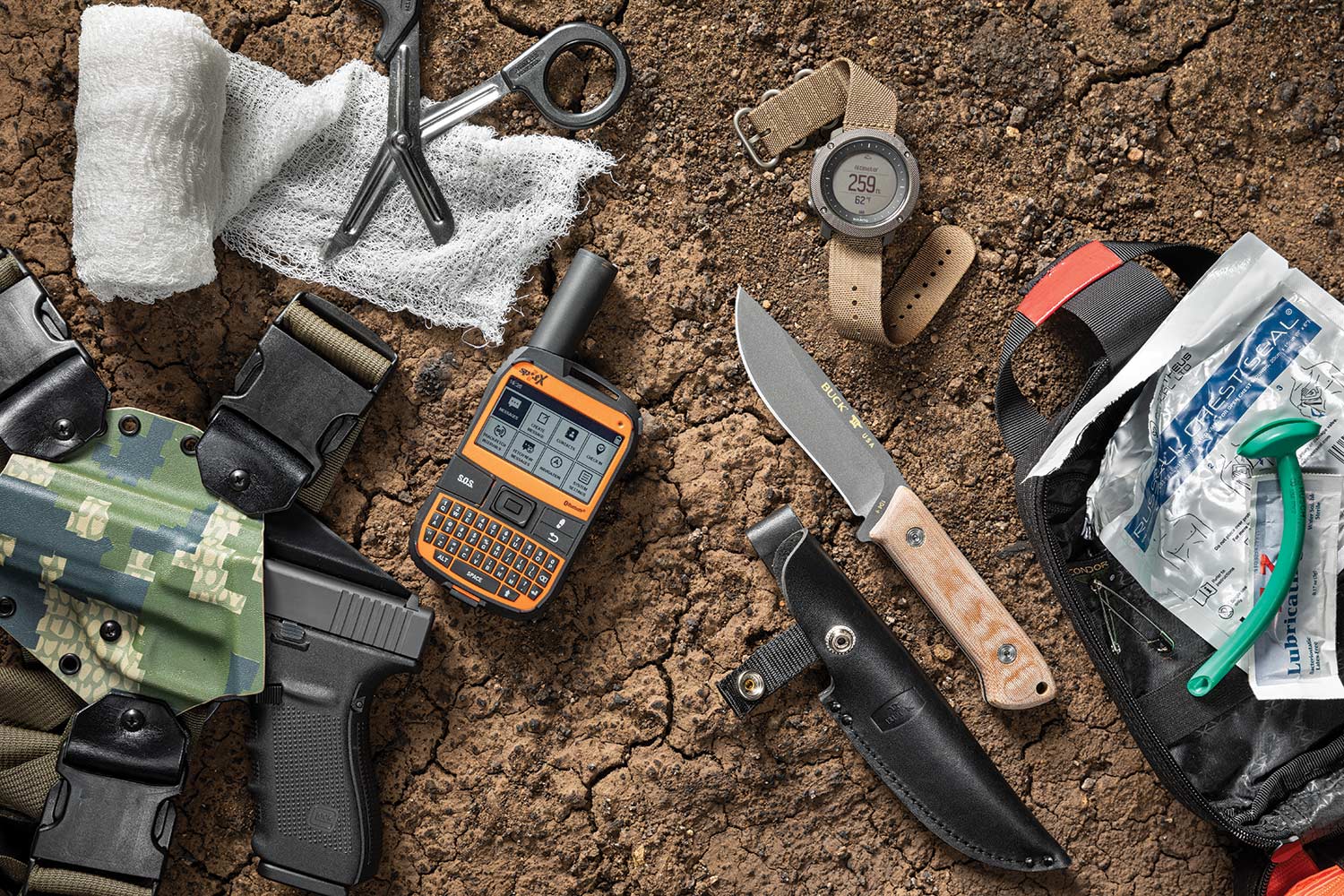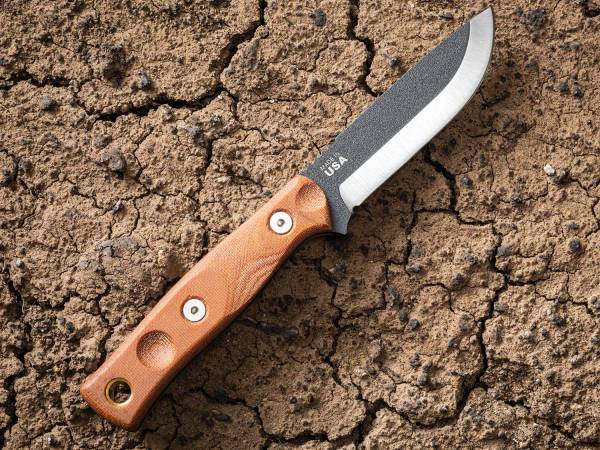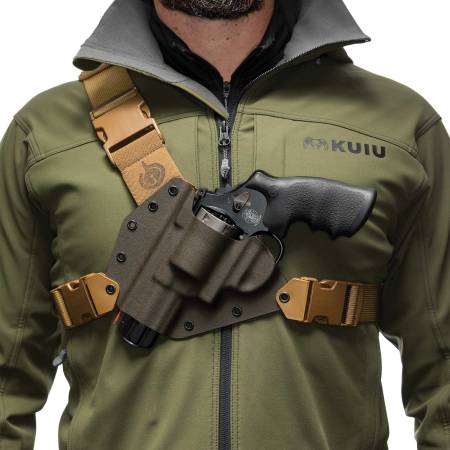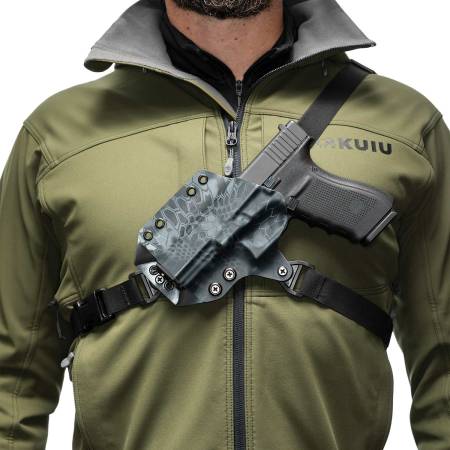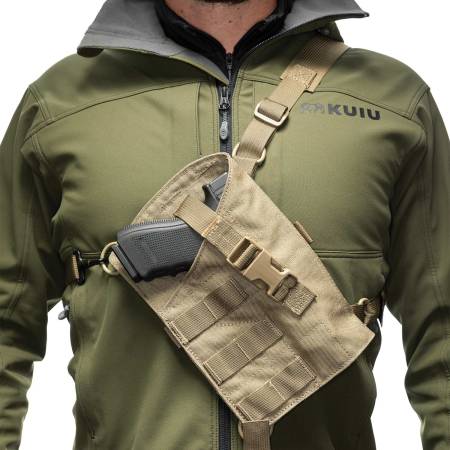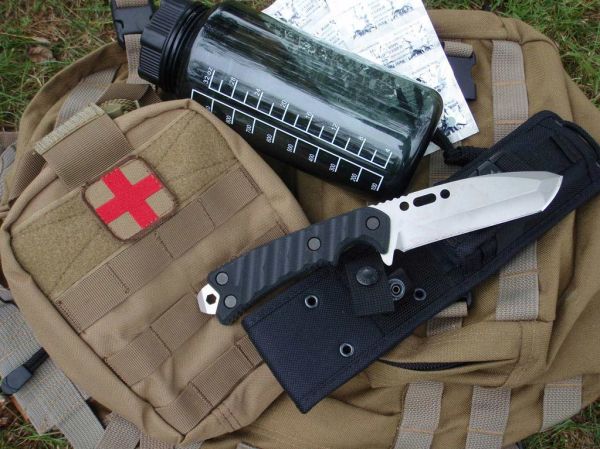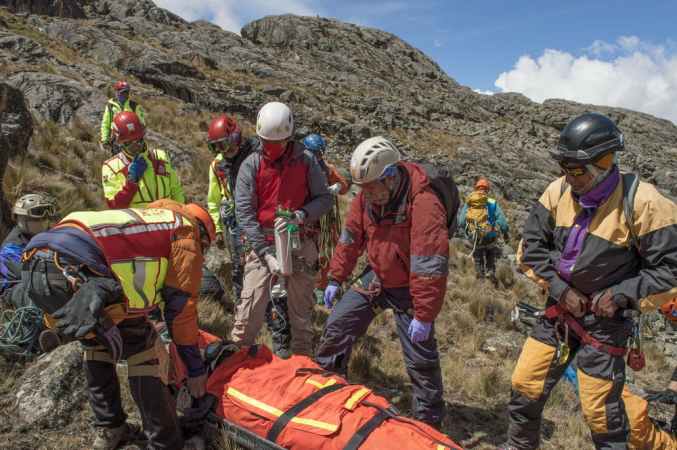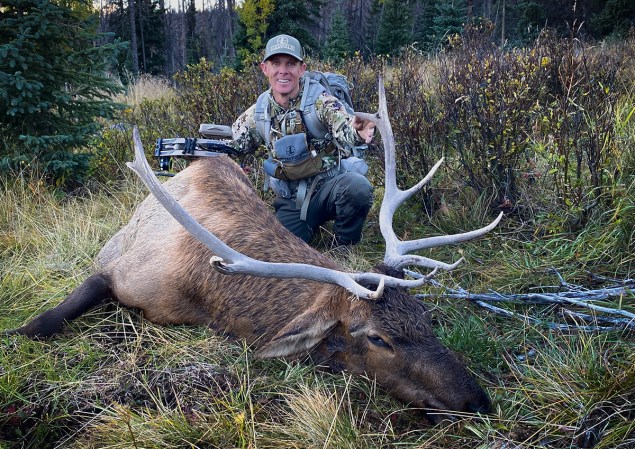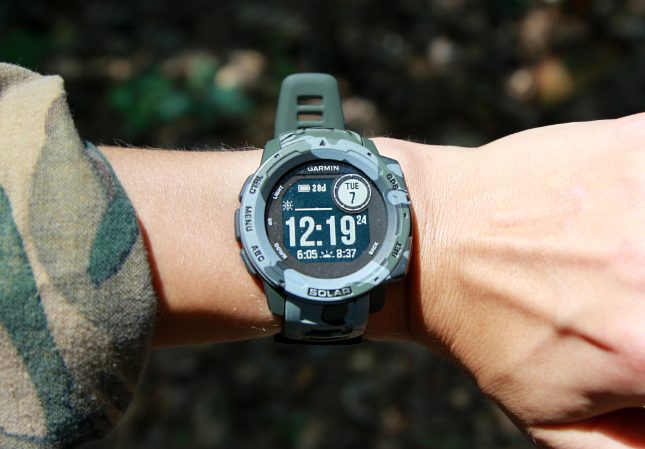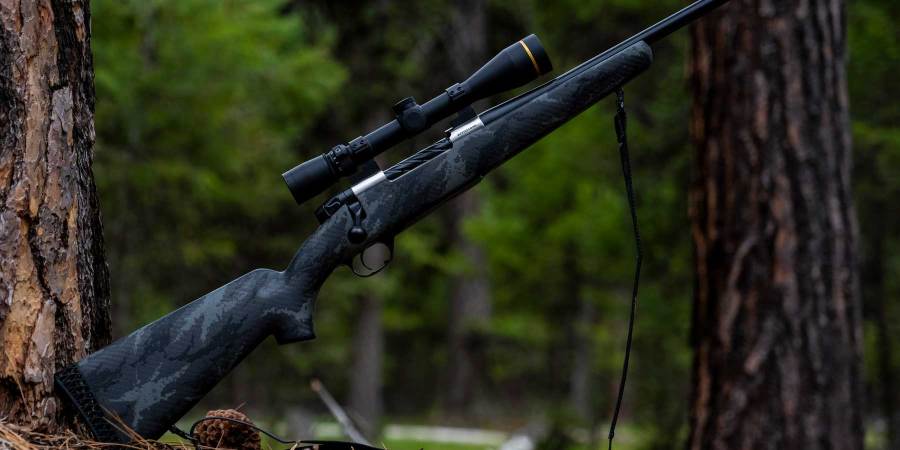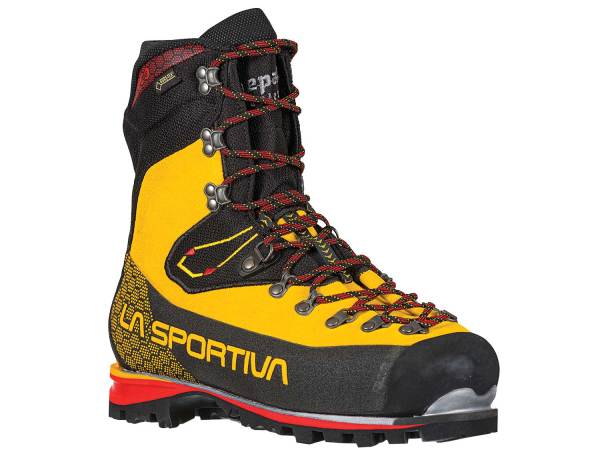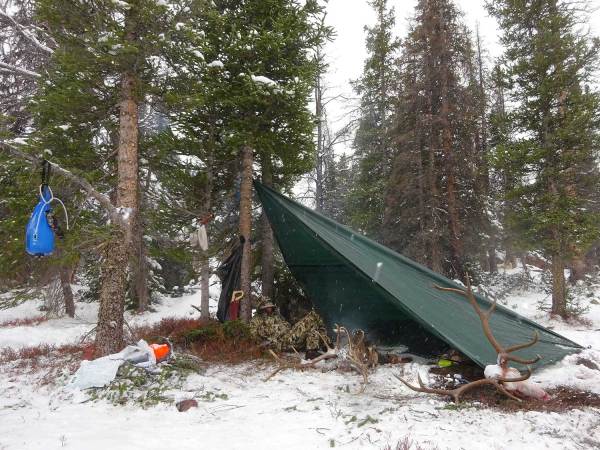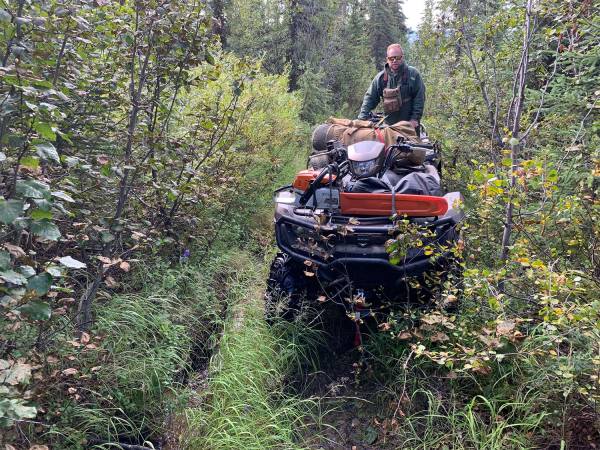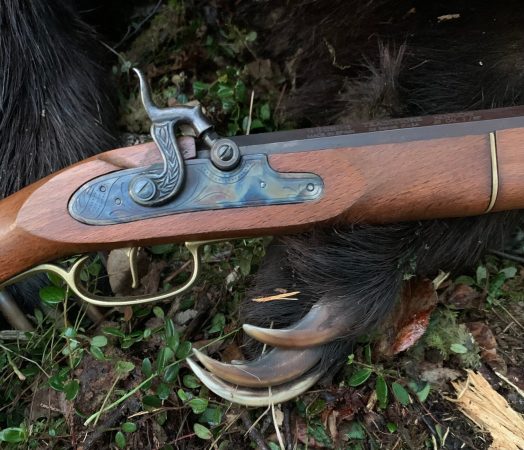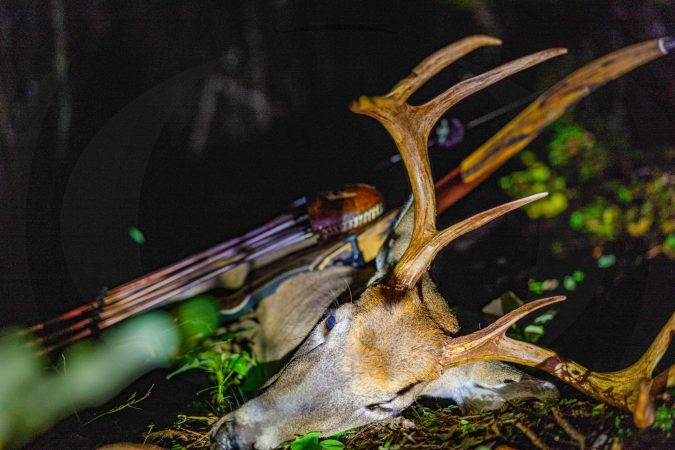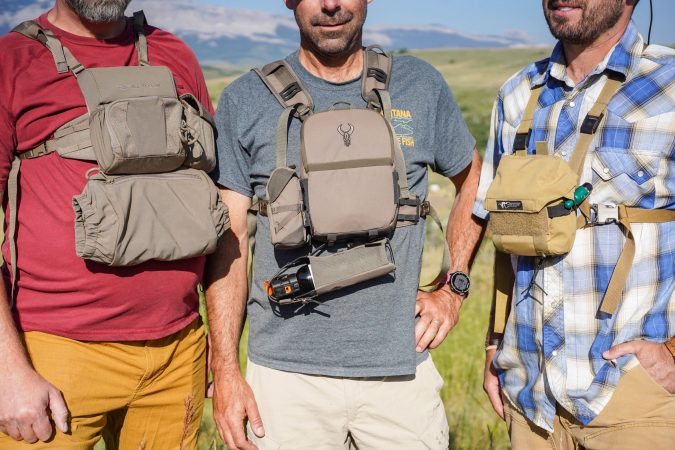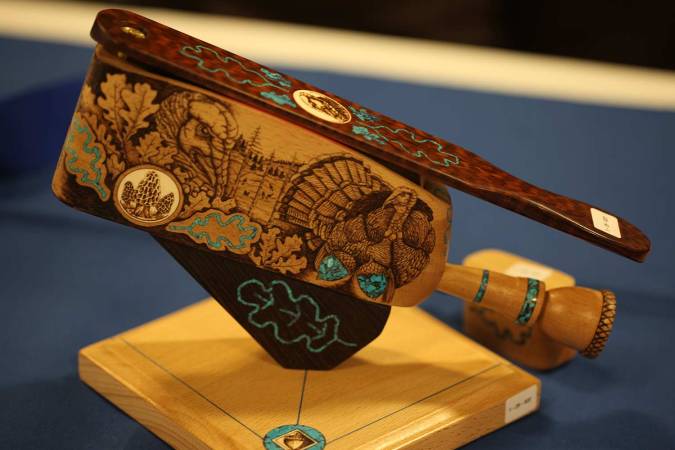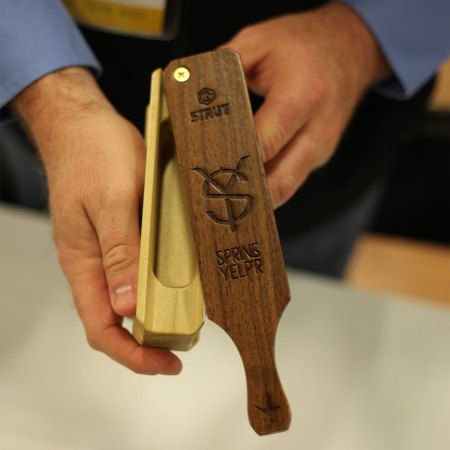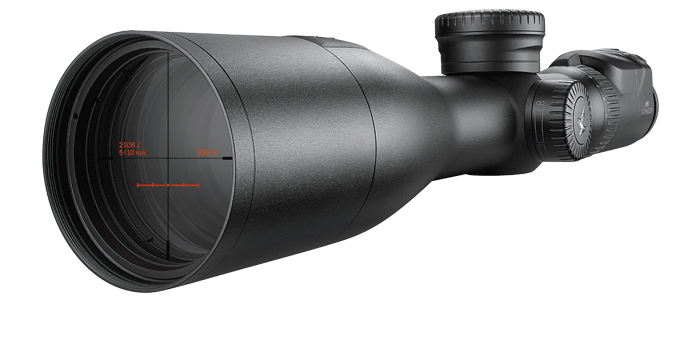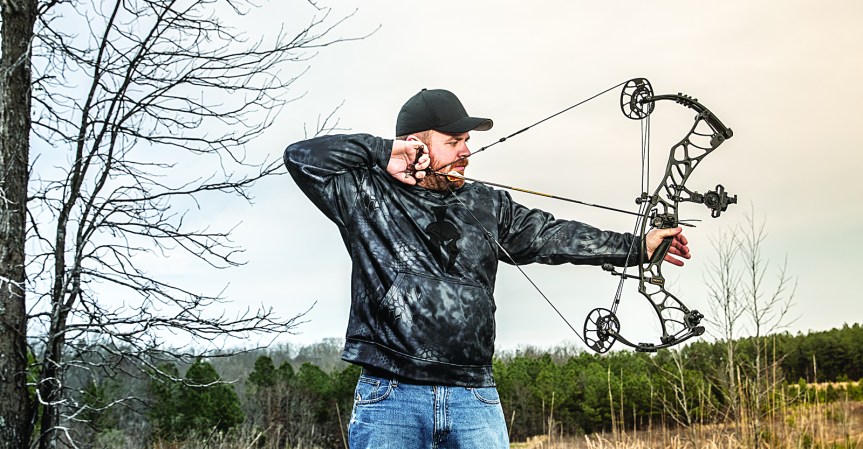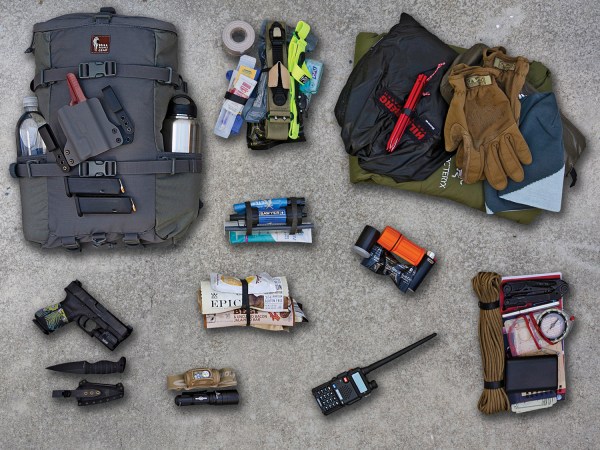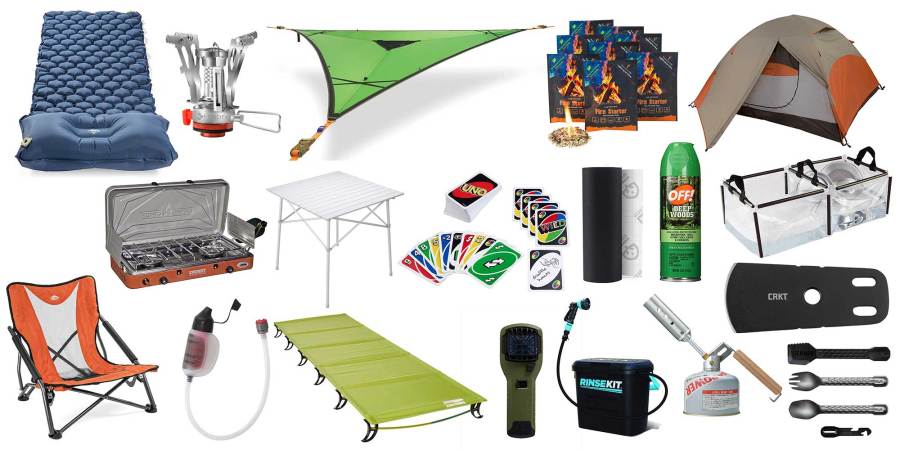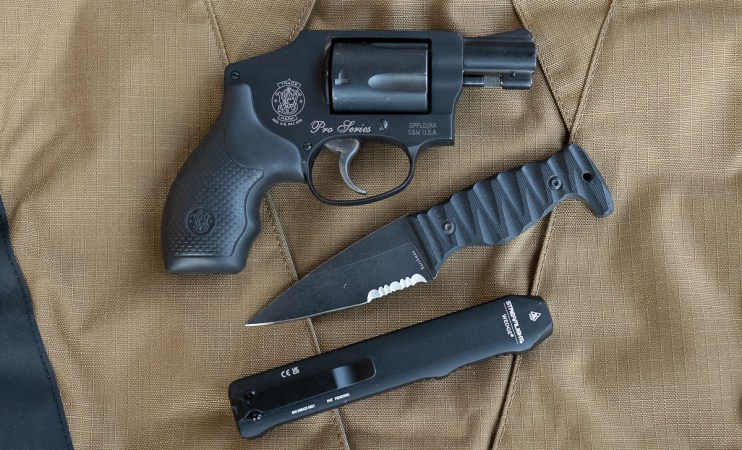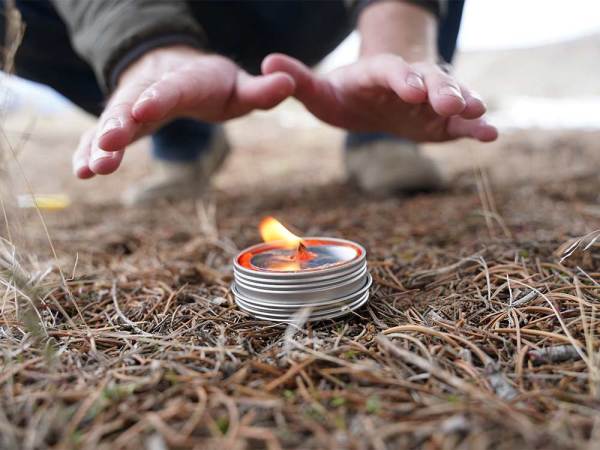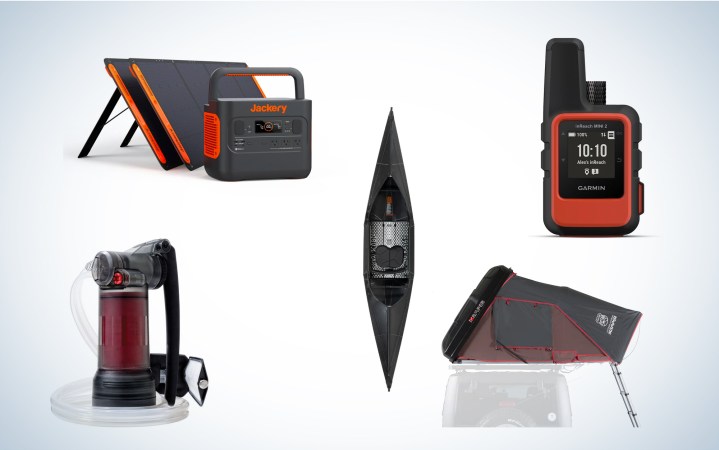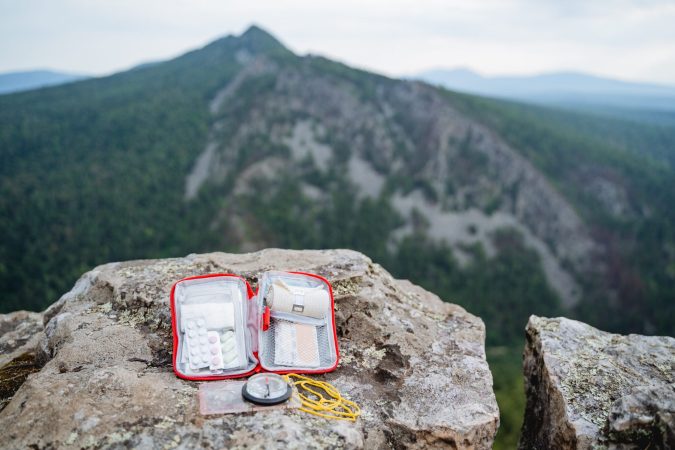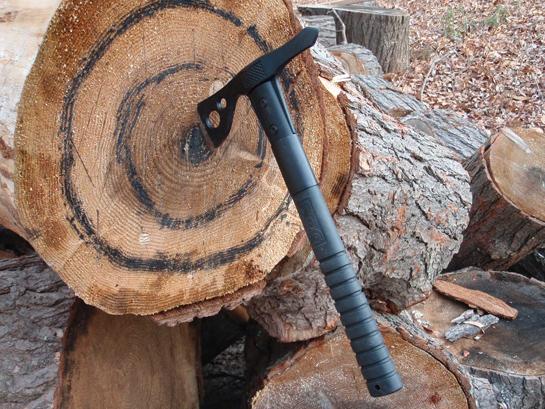We may earn revenue from the products available on this page and participate in affiliate programs. Learn More ›
“Don’t run to your death” is a well-known Navy SEAL saying that was meant for the battlefield, but it works pretty well in the backcountry too. The idea here, of course, is that taking things slowly and methodically will keep you out of trouble—and keep you alive.
It’s true: Most bad situations in the wilderness can be resolved with no tool other than common sense.
But some dangers can’t be avoided, no matter how much logic and caution we apply. Bears charge. Mountain storms brew in an instant. Hunting buddies get turned around. Accidents happen.
And when they do, this is the gear that you’re going to want stashed in your backpack, buckled to your hip, or strapped to your chest.
Bushcraft Knives
By Tim MacWelch
Tops Fieldcraft 3.5
Blade Length: 3.75 in • Overall : 8.25 in. Steel: 1095 • Handle: Tan canvas Micarta Weight: 5.5 ounces • Price: $145
You can do all kinds of things with a good bushcraft knife: hone a spear, strike up a fire, or dispatch a charging boar. But in reality, you’re going to use one of these blades to carve and baton wood for fire and shelter. You’re also going to use it to chop the random heavy stuff that your pocketknife can’t handle. For delicate carving tasks, you need surgical sharpness. For brute-force chores, you need durability. So, to test this field of bushcraft blades, I ran them through a battery of three tests: First, I batoned hardwood into 20 pieces of kindling; then I hacked away at whitetail antlers to test durability; and finally, I carved a feather stick to see just how precisely the knife would handle after the use and abuse. To succeed in these different tasks, each bushcraft knife needed the proper steel and edge geometry.
When the work was done, Tops Fieldcraft was the clear winner. Lean and lightweight, this knife has a slender profile even though it’s made from the thickest knife stock in our test group (4 mm). The grip is nice, and the brownish-tan Micarta handle scales are perfectly shaped. As for the sheath, there’s a lot to be said for the positive click that comes from locking your blade into Kydex. It might not look as “bushcrafty,” but who cares? It was the most trustworthy sheath in the field.
This graceful blade, with a classic Scandi grind edge and black traction coating, made quick work of the kindling. It also chopped into the antler for 10 hard hits without sustaining any damage or noticeable dulling. When it came time to carve the feather stick, the grind didn’t let me down. This knife was the best all-purpose bushcraft blade in the group.
Morakniv Garberg
Blade Length: 4.3 in. • Overall: 9 in. • Steel: Carbon steel • Weight: 9.6 ounces • Sheath: Leather or black Multi-Mount • Price: $110 • industrialrev.com/mora
This knife was robust, but not so heavy that it felt unwieldy. I opted for the Multi-Mount sheath kit for versatility. This MOLLE-compatible kit allows for many carrying options, and it corrects an old Morakniv problem—sheath retention. This system has a strap that wraps over the handle to secure the knife. My only complaint was that the handle material felt jarring against my hand. In the antler chop, the knife bit in deeply and suffered no damage after 10 hard strikes. The classic edge profile carved curly wood shavings with minimal effort.
Gerber Spine
Blade Length: 3.7 in. • Overall: 8.4 in. • Steel: 7Cr17MoV Weight: 6.6 ounces • Sheath: Green glass-filled nylon Price: $40
The Spine’s contemporary materials and strange sheath are almost futuristic in appearance, yet this knife has a traditional profile and feels familiar. It’s also the most affordable knife in our test. I loved the handle right away—it’s so grippy and comfortable, and I was pleasantly surprised by how it performed. The Spine batoned well, and its rubber grip was the most comfortable to work with. In the antler chop, the edge picked up a few minor chips. If you’re looking for an affordable, do-it-all bushcraft knife, the Spine is tough to beat.
Buck Compadre
Blade Length: 4.5 in. • Overall: 9.5 in. • Steel: 5160 spring steel • Weight: 7.1 ounces • Sheath: Black leather
The Compadre is a hollow-ground drop-point knife, making it quite different from the other blades in this field. It has a black Cerakote Cobalt coating, and the canvas Micarta handle scales are well-contoured, comfortable, and grippy without feeling rough. It passed the baton test with flying colors. It was the best knife for that task, even though it caused the coating to flake off. Unfortunately, it suffered the worst damage in the antler chop—there were at least six spots on the edge with damage, including chipping and rolling.
Helle Wabakimi
Blade Length: 3.3 in. • Overall: 7.9 in. • Steel: Triple-laminated stainless • Weight: 4.8 ounces Sheath: Brown leather
“Gorgeous” is the best way to describe this knife. The curly birch handle is a thing of beauty, as is the brightly polished stainless blade. It features a three-quarter tang that is mechanically fastened to the birch handle with two beefy brass pins and a small brass tube, which acts as a lanyard hole. The polished blade skated through the baton work, neatly splitting the kindling. On the chop test, the Wabakimi did show several spots of damage from the 10 aggressive strikes against the antler, but it still carved up the feather stick nicely.
Chest-Rig Holsters
By John B. Snow
Northwest Retention Systems Scout
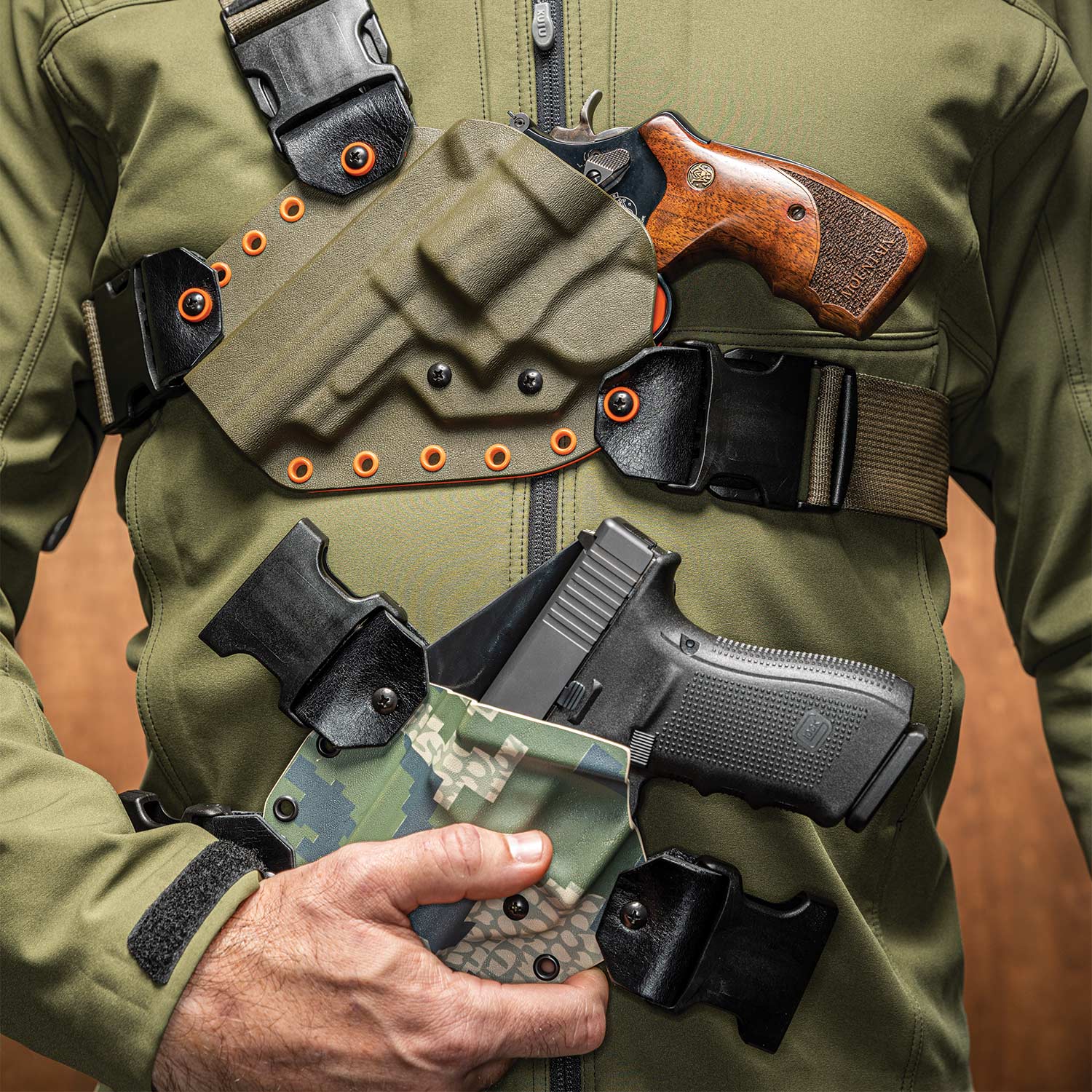
There are a number of ways to carry handguns in the backcountry, each with its pros and cons. Chest rigs have the advantage of being able to ride underneath and independent of a pack, keeping the handgun with you, and accessible, at all times.
I use chest rigs both while hunting and fishing in bear country. The only notable downside is that they don’t work great with bino harnesses—though there are some hybrid rigs that combine the two pieces.
The Scout from Northwest Retention Systems positions the handgun in the center of the chest with the grip canted at a 45-degree angle. Adjusted correctly, the three-point harness snugs the holster tight against the body, preventing it from moving around.
I have Kydex shells for both a Glock G20 and a Smith & Wesson 629 for my Scout. They are easy to swap out, and both do an excellent job of keeping the handgun secure while allowing for a smooth, easy draw. The degree of retention can be altered via tensioning screws on the shells. Most Scout holsters come with this feature.
The Scout can be ordered in multiple configurations featuring different-colored straps, buckles, shell interior, and exterior, and they’re able to accommodate guns with different sight heights, weapon lights, and red-dots.
All components on the Scout are built to survive the elements. The stainless-steel hardware, Cordura straps, Resolene-coated leather, and polymer buckles will stand up in pretty much any environment.
Gunfighters Inc. Kenai Chest Holster
This well-designed system is one of the most comfortable and secure for carrying a handgun in the backcountry. The wide straps distribute the weight of the firearm across the back and chest, and the easy-to-adjust straps snug the gun firmly against the body, eliminating excess movement.
The quality of the shell for my S&W 329 PD, and the amount of retention it provided, was top-notch. The Kenai doesn’t come with tension-adjustment controls, but in this case they weren’t needed. The Kenai lets you draw and reholster the firearm smoothly and easily. When ordering one, there are myriad custom options to choose from so you can tailor the rig to your specific needs.
Blackpoint Tactical Outback
This is the most minimal of the Kydex-holster chest rigs. The Outback has a single buckle to attach and remove the holster, compared with three on the other systems. The straps—made of a material called Ultracomp, which is durable and abrasion-resistant—are narrower than those of the other chest rigs here.
Because of the skinny straps, I found the Outback wasn’t as comfortable to wear for extended periods of time. And while it did a good job of securing the holster in the center of the chest, it had noticeably more play than the other systems. Nonetheless, I was able to draw and reholster my G20 with ease, bringing the pistol into action without a hiccup.
Viking Tactics Big Rig
The nylon pouch on the Big Rig comes in two flavors—one for a semi-auto, the other for a revolver. The universal fit gives it more flexibility than Kydex molded holsters, allowing the user to switch between handgun types more easily. But in order to draw the firearm, the shooter must unsnap a FastTech buckle on the retention strap, adding a step to the process.
To keep the holster in place, the Big Rig has an extra drop strap that hooks into a belt loop, preventing it from flopping around.
Molle webbing on the holster lets the user attach extra items, such as a mag pouch. The Big Rig also has belt loops so that it can be worn on the hip if desired.
A left-handed version will soon be available.
Hill People Gear Heavy Recon Kit Bag
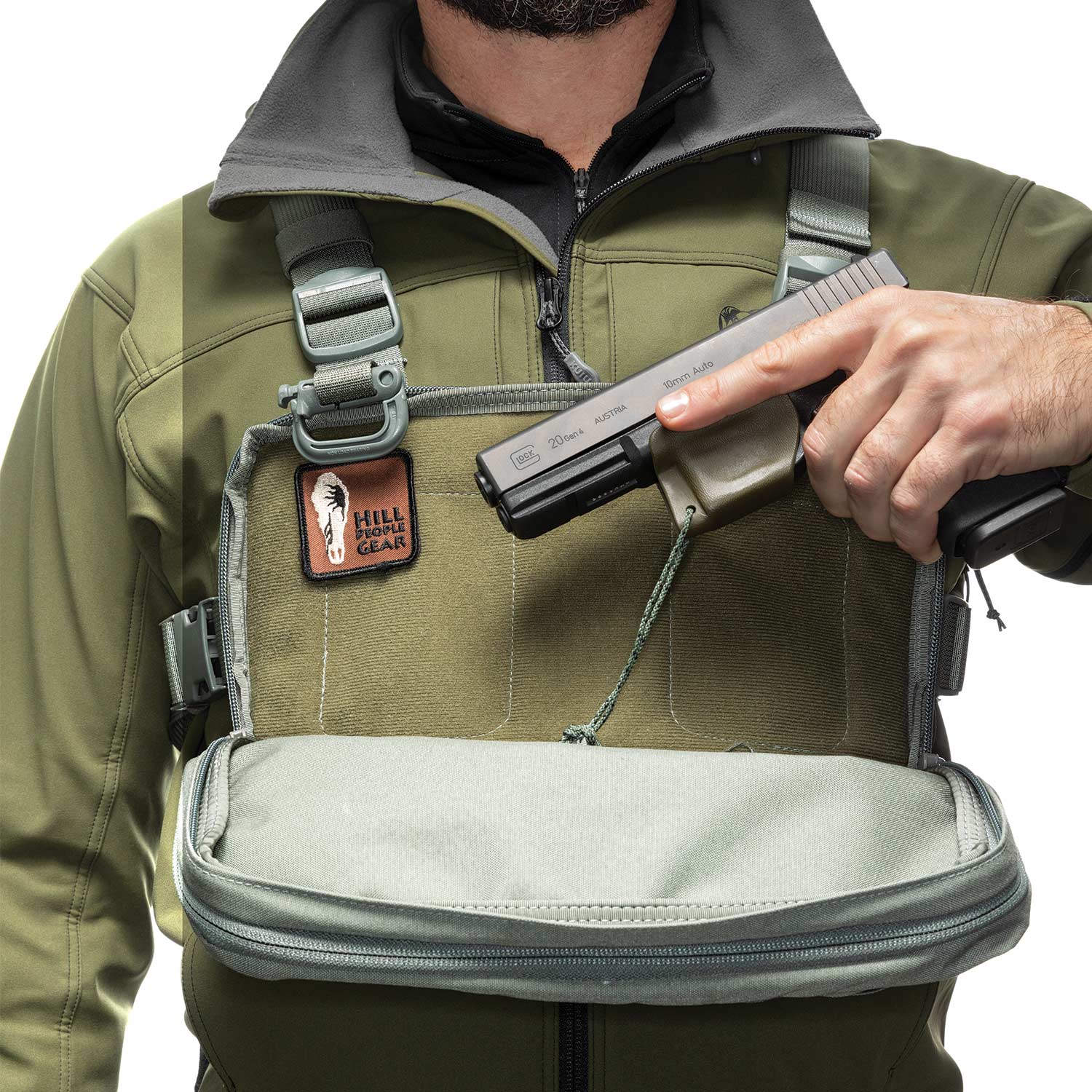
This chest pouch has a rear compartment that closes with a zipper, in which the user can keep a handgun. Typically, I keep the strong-hand side of the pouch unzipped so I can get my hand on the gun quickly if needed.
For maximum safety, I combined the Kit Bag with a Fricke Zacchaeus holster ($28) that snaps onto the trigger guard of my G20. The holster has a lanyard that can be tied off to a loop in the bag. When the pistol is yanked free of the bag, the holster slips off the trigger guard.
This bag is supercomfortable to wear and has the added utility of a front compartment that can be configured with pouches and Molle-compatible accessories.
Read Next: Ultimate Survival Kit: 10 Pieces of Gear That Will Save Your Life
Assemble an IFAK
By Mike Shertz
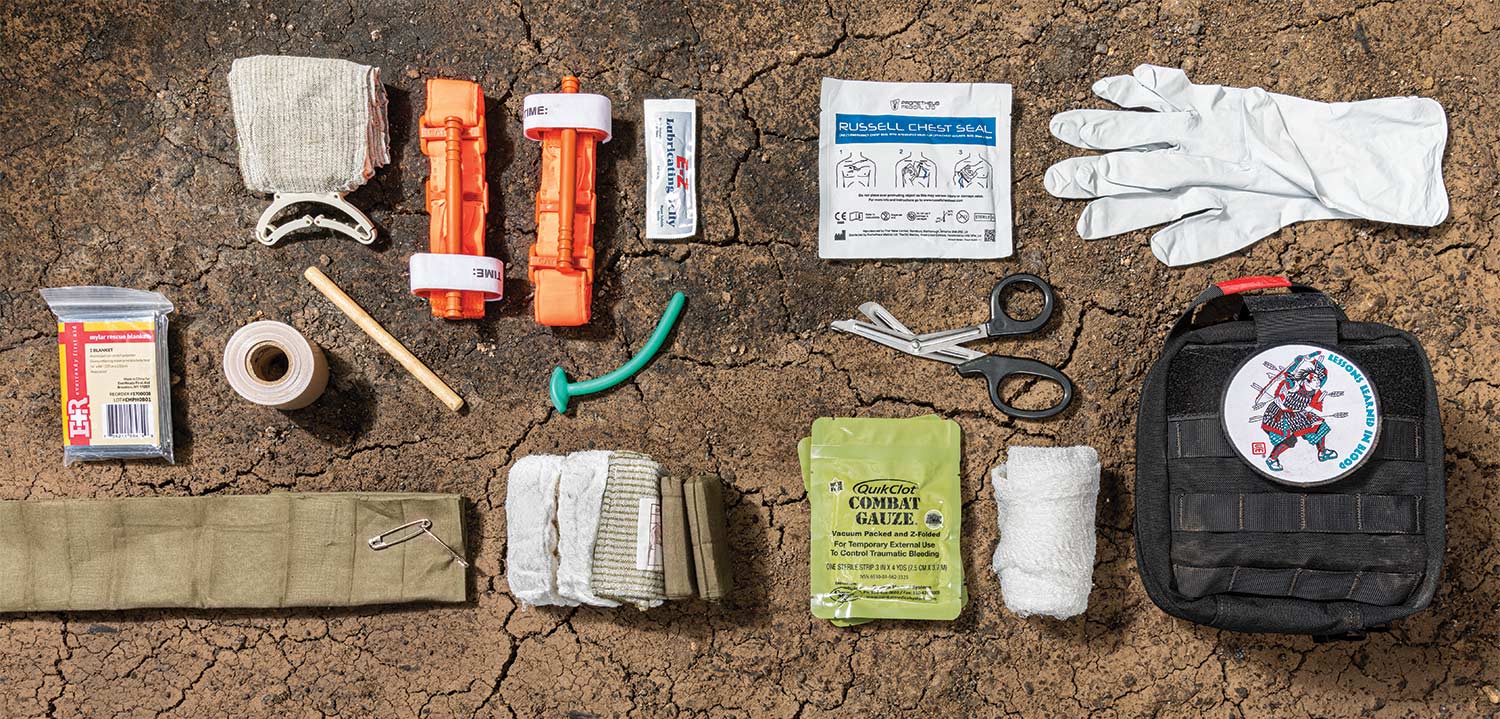
If you spend enough time around firearms or edged tools, sooner or later you are likely to see someone get shot, sliced, or stabbed. Here’s what a former U.S. Special Forces medic recommends carrying in case it happens. You might just save that person’s life.
1. ETD
An emergency trauma dressing (ETD) or “Israeli dressing” is a gauze pad sewn to an elastic wrap that lets you cinch the dressing tight against a wound. It is an ideal pressure dressing but is also versatile enough to be used on any wound. Once you have packed a wound, a pressure dressing helps keep the gauze in place. The last thing you want is for the wound packing to work its way loose and have the bleeding start again. Although available in 4- and 6-inch versions, we find the 4-inch size more useful in civilian trauma. Both PerSys and NAR sell good ETDs.
2. Tourniquets
Applied correctly, a tourniquet provides direct pressure around the circumference of a limb. Though nearly 100 percent effective on an arm, a single tourniquet might be only 70 percent effective at stopping blood flow on a thigh, which is why I recommend carrying at least two in an IFAK. Two tourniquets applied side by side on a thigh can be 80 percent effective. I prefer NAR Combat Application Tourniquets because evidence gathered from the field indicates they work the best. No commercial tourniquet has been shown to work better.
3. Chest Seal
Gunshot wounds to the chest bleed little externally. Medical professionals debate whether they need to be “sealed.” Sucking chest wounds, although dramatic, are not necessarily life-threatening. If you include chest seals in your IFAK, you need one that will let air out, or is “vented.” Russell chest seals performed best in a recent study.
4. Gloves
Disposable nitrile gloves are the best protection from blood-borne diseases. Light-colored gloves are preferable since blood is not as visible on darker ones.
5. Space Blanket
Individuals in shock from blood loss rapidly become hypothermic. Also, it is imperative to remember that cold blood does not clot. An inexpensive space blanket is the best option in a small kit.
6. Duct Tape
Duct tape is always useful. I carry 5 yards of NAR Gecko Grip tape.
7. Dowel
This is a 6-inch wooden dowel with a 3/8-inch diameter. If you craft an improvised tourniquet with a cravat (see No. 10), use the dowel as a windlass to tighten it down and stop the bleeding.
8. Nose Hose
Technically called a nasopharyngeal airway, this soft tube can be placed through the nose to help a casualty breathe better. A water-soluble lubricant makes insertion easier. If you don’t have a nose hose, the standard Red Cross head tilt and chin lift that is taught in basic CPR classes can help open the airway.
9. Shears
Having safety shears to cut away clothing and expose a wound is helpful. You can do this with a knife but risk cutting your victim. Shears come in 5- or 7-inch sizes. Either is fine for this kit.
10. Cravat
The classic military triangular bandage, or cravat, is made of muslin cotton. It is a multiuse medical item that can be employed as a sling or an improvised tourniquet, or to secure splints, form a pressure dressing, or create a tight bandage over a gauze-packed wound. Military cravats are made of stronger material and are of higher quality than their cheap civilian counterparts.
11. Safety Pins
The safety pin has been a versatile piece of equipment for more than 150 years. Each military cravat comes with two.
12. Gauze
For junctional injuries in the neck, groin, or armpit, which are too high for a tourniquet, you will need to pack the wound. This involves forcing gauze deep into the wound at the point of bleeding. Although basic cotton gauze works, hemostatic gauze, which is impregnated with an agent that encourages blood clotting, can be more effective. Of the commercially available hemostatic gauzes, Combat Gauze has the most evidence supporting its use. In my Army Special Forces career, we routinely packed significant junctional wounds with inexpensive cotton Kerlix gauze. Studies show this works just as well as hemostatic gauzes if you know what you are doing. I recommend carrying at least two rolls, which I’ll often pull out of their individual packaging and vacuum-seal together. Unfortunately, you can go through a lot of gauze packing a wound. If you can afford to add Combat Gauze to your IFAK, I’d recommend it.
13. Bag
Make sure the bag fits all the gear you want to include and mark it with red so it is easy to identify in an emergency. This Condor Rip-Away EMT pouch is one I like to use.
GPS & Satellite Devices
By Tyler Freel
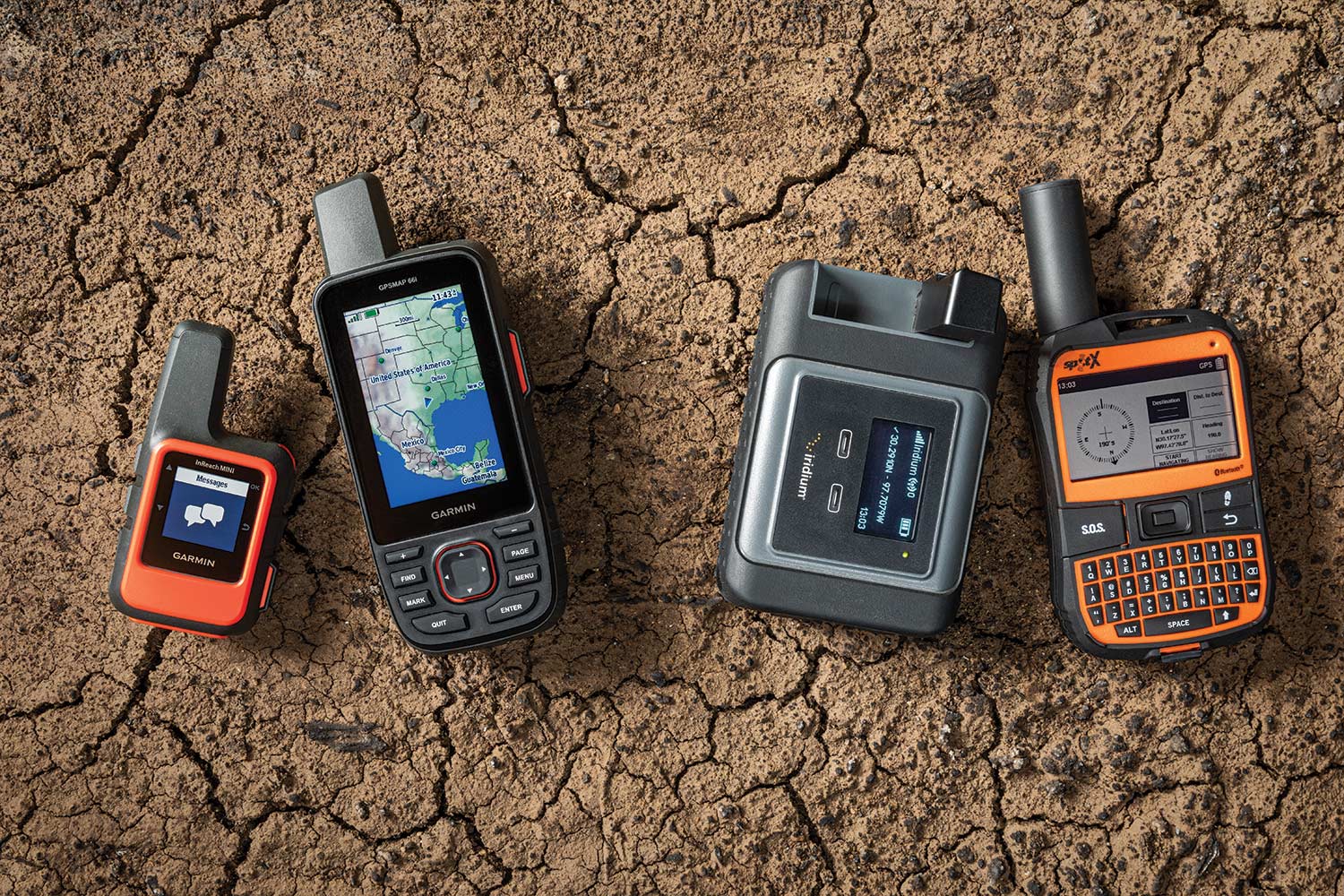
Garmin inReach Mini • $350
The Mini from Garmin combines GPS mapping and navigation with satellite text-message communication. It also has an emergency SOS button that will summon rescue services to wherever you are. The GPS mapping and messaging functioned flawlessly here in Alaska (extreme latitudes can sometimes be trickier for satellite devices), and it also functioned well on the other side of the globe when I tested it on a hunt in South Africa. The unit is ruggedly constructed and can easily clip onto your backpack or be stowed for ready access. True to its name, this thing is tiny—it weighs only 3.5 ounces. The unit is designed to be used through your smartphone via Bluetooth for all functions, but it does have a small screen, so basic functions and SOS can be performed manually within the unit if you lose or drown your phone. You must purchase a data plan through Garmin, and an app on your phone gives you access to mapping, navigation, and communication. As a default, each text message you send is accompanied by a pin dropped on a topo map to the recipient. The battery will last for more than a week if used sparingly. The inReach Mini is ideal for backpack hunters who want to utilize basic GPS functions and navigation along with two-way communication.
Garmin GPSMAP 66i • $600
inReach technology, which allows you to use satellite communication through your cellphone anywhere in the world, is one of the biggest advancements to hit the backcountry within the past decade. These devices have saved lives and given many family members peace of mind. The 66i is the first Garmin to utilize inReach technology in a more traditional, full-size GPS unit.
The 66i’s predecessor, the inReach Explorer, had a user-friendly GPS screen, but it wasn’t as developed as top-end GPS units. This unit is ideal for people who aren’t worried about weight and need a dedicated GPS unit with a sizable screen while also having the benefit of satellite communication. I’d love one of these mounted on my boat console while running remote rivers in Alaska. The inReach text and SOS functions are essentially the same as the Mini’s, and the 66i also interfaces with your smartphone via Bluetooth, but it uses different apps. Aside from messaging, you won’t need to use your phone as much with this unit because the buttons and menus are easy to navigate on the unit itself. You can download a variety of maps at home and then use them in the field. The 66i really shines when it comes to tracking, marking waypoints, and navigation functions.
Iridium Go! • $900
Iridium has the reputation here in Alaska as being the most reliable satellite network for communication. Its satphones are the only ones you will find here in the bush (in fact, the inReach devices also work on this reliable network). For traveling outdoorsmen and -women, however, the standard satellite phone is quickly becoming outdated, and Iridium is keeping up with the times through its new Go! unit.
This is a satellite communicator that allows you to use your iPhone or Android as a satphone, and you can even use it as a text or calling hotspot for multiple devices. You can also send and receive email, and post to some social media platforms. Just expect calls to have similar audio quality and delay as with any satellite phone. While testing the unit in Alaska, I found it to be intuitive and perfectly functional. As with other communicators, the Iridium Go! has an external SOS button, which will send an emergency signal and initiate a rescue to your location. The Go! is a bit bigger than most two-way texting communicators (at 10.6 ounces, it’s about the weight of a standard satphone), but if communication in the backcountry is what you really need, this unit is the way to go.
SpotX Communicator • $250
Spot was one of the early names in satellite communication, providing a way to send prewritten messages, location tracking, and emergency signals in a package that was much more affordable than a satphone. These units were groundbreaking, but one-way communication is now outdated. So the new SpotX is a welcome upgrade for backcountry hunters.
Like the other units, it interfaces with your smartphone via an app, supports two-way text messaging, posts to some social media platforms, and has an emergency SOS-signal function. The SpotX is slim and lightweight, charges with a standard mini USB cord, and features a BlackBerry-like manual keyboard, which makes composing messages on the unit itself much easier. Your text messages are accompanied with a coordinate link to your exact location, so your loved ones can track you. Coverage is worldwide excluding satellite dead zones, and I was able to use it reliably on a hunt in South Africa. SpotX uses the Globalstar satellite network; in testing, it seemed to be slightly slower than the Iridium network, but I didn’t have any messages fail to send. This is an affordable option for folks who occasionally venture into the wilderness but still want to send messages back home.
GPS Watches
By Tyler Freel
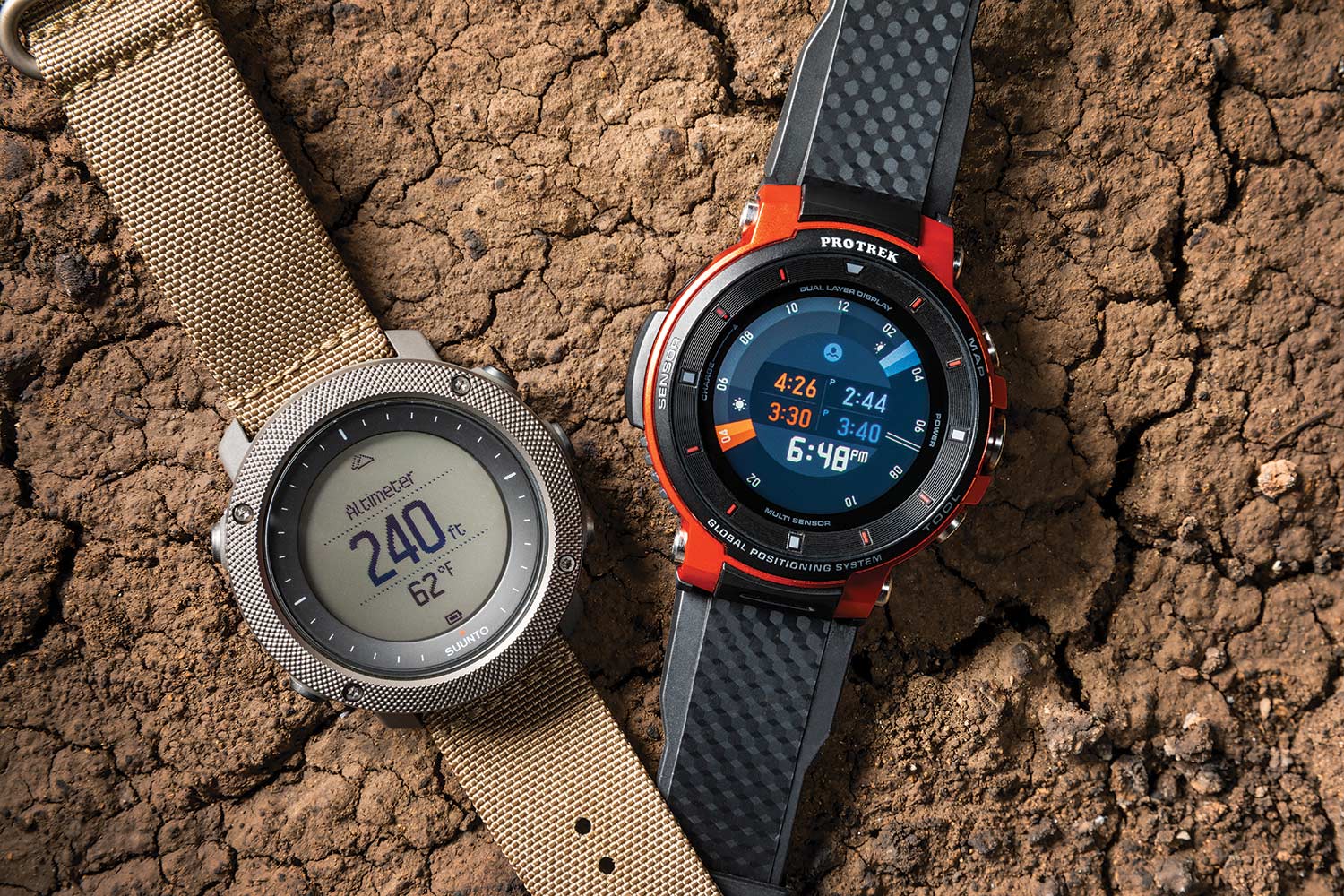
Suunto Traverse Alpha • $349
Smartwatches aren’t just for counting your steps—there are several quality watches on the market with legitimate satellite GPS functions. The Traverse Alpha is one of the front-runners, from a brand that has a reputation for producing rugged yet feature-rich gear. This watch has quality components, including a composite housing and a knurled, stainless-steel bezel (which is the area that takes most of the abuse on any watch). The canvas wrist strap provides a secure grip that isn’t clammy like some watches with rubber bands. The display features a night-vision-compatible backlight and flashlight, and you can quickly cycle through the basic function screens for time, barometer, compass, and elevation. It interfaces with your smartphone via an app, so you can track workouts and health stats, as well as lay a track on a map. The display on the watch itself doesn’t show topographical features, but you can easily set waypoints, tracks, and navigate to waypoints using just the watch, which is handy when you drop your pack for an evening stalk in the mountains. The battery will last a long time on basic functions, but tracking eats up the charge more quickly. The watch is juiced up through a proprietary charger, so you’ll probably want to order a spare.
Casio Pro Trek WSD-F30RG • $550
This smartwatch from Casio brings lots of features to the backcountry, including a durable, dual-layer LCD color touchscreen and numerous options for display settings. The watch syncs with your phone via an app, and additional apps can be downloaded to the watch itself. It also features a built-in microphone for voice-activating apps and controls when you want to go full James Bond mode. The watch comes with a barometer, a compass, and other basic functions you’d expect in any smartwatch made for the wilderness. But it also features advanced route tracking, which incorporates detailed, downloadable maps on the watch itself (not just through an app on your phone), so you can really use this thing to navigate. It’s also great for recording workout stats as well as hiking routes and waypoints. With so many features jammed into such a small package, getting used to the functionality takes some time. The only real catch is the short battery life. On the upside, it can be set to battery-saver mode, in which you can expect a week or more out of a charge. But when you start running the more advanced functions, you’ll need to charge the watch every day. The Pro Trek also uses a proprietary magnetic charging cord, which is cool—just don’t lose it.
